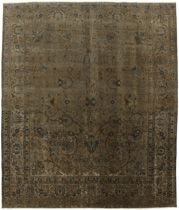Main Category
Origin
|
Size/Shape
|
Joshaghan - Isfahan Persian Rug 11'4"x9'4"
The colours of each carpet look different depending on the side from which you look at it. You can see the carpet from different perspectives in the images below:
(click on the images below for greater detail)
- Discount Price: £ 1429 -50%
- Retail Price: £2858
- Rug Code: cls1145-598
- Size: 11'4"x9'4"
- Thickness: Medium (5-10 mm)
- Age: 0-20 (New)
- Pile - Warp: Wool on Cotton
- Knot Density: approximately 120.000 knots per m²
- Rug colors:
-
Important note:
The rug is a little crooked - uneven
Joshaghan Rugs : Joshaghan is a town located in central Iran, north of Isfahan city and very close to the town of Kashan. Characteristic designs of the Joshaghan rugs are Rhombi. Also characteristic are the repetitive designs of flowers "mina khani", henna flowers, or even pomegranate trees. On the borders there are perimetrically woven meanders. Red is the dominant colour used on a blue or beige background. The best rugs are from the Joshaghan and are called Muchakar or Murcecar and Meymeh.
Isfahan Rugs : In the centre of Iran among the Zagros Mountains and the desert, lies the city of Isfahan. Nowadays it is an important industrial city with a population of 1.2 million. The town is an architectural masterpiece. The old rugs of Isfahan incontrast with the newer ones didn't have got a central medallion. The entire surface of the rug was filled with elaborate spiral flowers and flower palmettes. The newer Isfahan rugs cannot be compared with those wonderful old specimens which were manufactured exclusively for nobles. But continuing the tradition, today's rugs of Isfahan also have a very fine weave and are clipped very short to reveal their design more clearly. In the weaving they also use silk to highlight certain areas of the design, especially in flowers. The warp is made of silk or cotton.
Classic rugs: Rugs that are woven in urban centres in fixed workshops and looms(as opposed to nomads). Their designs are first done on paper by rug designers. These designs are strictly conducted by the weaver during the manufacturing. Even in these rugs, though there may be slight variations in weaving.
All CarpetU2 carpets are subject to cleaning with high quality antibacterial and moth protection products according to Persian law.
Abrash: Due to the different amount of grease in the wool and the added salt during the process of dyeing, the wool has got a varying colour absorbance. This is not very visible before weaving. During the weaving though, lines of the same colour are formed in the rug. This is called Abrash (which in Farsi means little cloud) and it shows that the wool was not manufactured using chemical means and marks the naturalness and authenticity of the rugs. Examples
Similar Rugs You Might Also Find Interesting
You have to choose at least two (2) rugs!
You can select up to six (6) rugs to compare!

 Click here for larger image
Click here for larger image




















